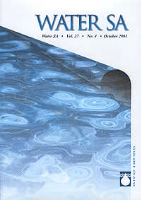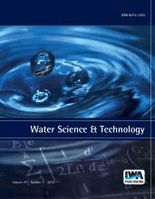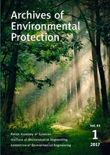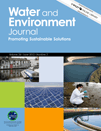
npj Clean Water
Scope & Guideline
Fostering knowledge sharing for cleaner water solutions.
Introduction
Aims and Scopes
- Water Treatment Technologies:
Research on advanced water treatment methods, including membrane technologies, bioreactors, and photocatalytic processes aimed at removing contaminants and improving water quality. - Sustainable Water Management:
Studies that emphasize sustainable practices in water management, including resource recovery from wastewater, water conservation techniques, and the integration of water-energy nexus approaches. - Pollution Monitoring and Control:
Research dedicated to monitoring water quality, understanding pollution pathways, and developing methods to mitigate the impact of pollutants, particularly in urban and agricultural contexts. - Public Health and Water Safety:
Investigations into the health impacts of water quality, including the presence of pathogens and contaminants, and the effectiveness of point-of-use treatment technologies. - Emerging Contaminants:
Focus on the detection and remediation of emerging contaminants, such as pharmaceuticals and personal care products, in aquatic environments. - Innovative Materials and Nanotechnology:
Exploration of new materials, including nanomaterials and hybrid systems, for enhanced performance in water treatment applications.
Trending and Emerging
- Resource Recovery from Wastewater:
An increasing number of studies focus on recovering valuable resources, such as nutrients and energy, from wastewater, underscoring a shift towards circular economy principles in water management. - Smart Water Management Technologies:
There is a growing emphasis on the use of smart technologies, including machine learning and IoT applications, for optimizing water treatment processes and improving water quality monitoring. - Microbial and Bio-inspired Solutions:
Research into the use of microbial processes and bio-inspired designs for water treatment is gaining traction, reflecting a trend towards sustainable and natural solutions. - Impact of Climate Change on Water Resources:
Studies addressing the implications of climate change on water availability, quality, and management practices are increasingly prevalent, highlighting the urgent need for adaptive strategies. - Integrated Approaches to Water-Energy Nexus:
Emerging research explores the interconnectedness of water and energy systems, focusing on technologies that optimize both resource use and environmental impact. - Advanced Materials for Water Purification:
The development of novel materials, such as nanocomposites and hybrid membranes, for enhanced water purification processes is a prominent theme, reflecting innovation in material science.
Declining or Waning
- Traditional Water Treatment Methods:
There appears to be a waning focus on conventional treatment methods, such as standard filtration and chlorination, as more innovative and efficient technologies gain prominence. - Simple Desalination Techniques:
Research on basic desalination methods has decreased as the journal shifts towards more complex, integrated systems that combine desalination with other processes like resource recovery. - Static Water Quality Assessments:
The journal has moved away from purely static assessments of water quality towards dynamic, real-time monitoring and predictive modeling approaches. - Single-Contaminant Studies:
There is a noticeable decline in studies focusing solely on single contaminants, as the trend shifts towards understanding the interactions and cumulative effects of multiple pollutants. - Conventional Wastewater Treatment:
Research on traditional wastewater treatment practices is less frequently published, as the focus has shifted towards advanced oxidation processes and hybrid systems that enhance efficiency and sustainability.
Similar Journals

Desalination and Water Treatment
Innovating Solutions for a Thirsty WorldDesalination and Water Treatment is a pivotal journal in the realm of water science and technology, focusing on the critical issues surrounding water desalination and treatment processes. Published by DESALINATION PUBL in the United States, this journal, with ISSN 1944-3994 and E-ISSN 1944-3986, serves as an essential resource for researchers, professionals, and students engaged in ocean engineering, pollution control, and innovative water management strategies. With a transitional coverage from 2009 to 2024, it holds a respectable position in the third quartile of various categories, including Ocean Engineering, Pollution, and Water Science and Technology, as of 2023. The journal is indexed in Scopus, reflecting its contribution to the field by ranking within the 39th to 45th percentile across relevant subject areas. Although not an open-access publication, it remains a crucial platform for disseminating influential research, thereby enhancing the global repository of knowledge on water treatment methodologies and sustainable practices in desalination.

Journal of Contemporary Water Research & Education
Exploring Contemporary Issues in Water ManagementJournal of Contemporary Water Research & Education is a leading publication in the field of water resources, committed to advancing the understanding and management of water-related issues through innovative research and education. Published by WILEY, this journal serves as a vital platform for researchers and practitioners to disseminate knowledge on contemporary water challenges, management strategies, and environmental policies. With an ISSN of 1936-7031 and an E-ISSN of 1936-704X, it provides a wealth of peer-reviewed articles that are essential for anyone interested in sustainable water resource practices. Although it does not currently operate under an open-access model, the journal's comprehensive content remains accessible through various institutional and personal subscriptions. As we face increasing water scarcity and quality issues globally, the Journal of Contemporary Water Research & Education strives to foster collaboration and innovation, playing a pivotal role in equipping scholars, professionals, and students with the knowledge necessary to tackle these pressing challenges.

JOURNAL OF SOIL AND WATER CONSERVATION
Exploring the nexus of soil health and water sustainability.The JOURNAL OF SOIL AND WATER CONSERVATION, published by the Soil Water Conservation Society, is a leading peer-reviewed journal dedicated to the critical fields of agronomy, soil science, and water conservation. With its inception in 1973 and a convergence period extending to 2024, the journal plays a pivotal role in disseminating innovative research, management practices, and policy analysis aimed at promoting sustainable land and water resource management. The journal boasts an impressive Impact Factor and ranks in the Q1 and Q2 quartiles across key categories, including Agronomy and Crop Science, Nature and Landscape Conservation, and Water Science and Technology. It serves as an essential platform for researchers, professionals, and students to engage with cutting-edge findings that address pressing environmental challenges. Through its commitment to advancing the science of soil and water conservation, this journal remains a vital resource for enhancing ecological integrity and promoting sustainable agricultural practices.

WATER SA
Exploring the intersection of technology and water sustainability.WATER SA, published by the WATER RESEARCH COMMISSION, serves as a pivotal platform for interdisciplinary research in the areas of water science and technology. With an ISSN of 0378-4738 and an E-ISSN of 1816-7950, this open-access journal has been committed to disseminating knowledge since 2005, ensuring that research is freely accessible to a global audience. As of 2023, it holds a Q3 ranking in several key categories including Applied Microbiology and Biotechnology, Management, Monitoring, Policy and Law, Waste Management and Disposal, and Water Science and Technology. These rankings reflect its significant contribution to these disciplines, particularly in South Africa where it is based. With a history dating back to 1976 and converging research efforts extending through 2024, WATER SA aims to illuminate pressing water-related challenges and foster innovative solutions through rigorous scientific inquiry. Researchers, professionals, and students interested in the sustainability and management of water resources will find its comprehensive portfolio essential for advancing their work and understanding in an increasingly critical field.

WATER SCIENCE AND TECHNOLOGY
Connecting knowledge and technology for sustainable water practices.WATER SCIENCE AND TECHNOLOGY, published by IWA PUBLISHING, is a leading academic journal dedicated to advancing the field of water science and technology. With a rich history dating back to 1970, the journal provides a platform for innovative research and technological advancements, catering to the vital challenges faced within the realms of environmental engineering and water resource management. As evidenced by its strong ranking in Scopus, where it holds a position of #86 in Water Science and Technology and #77 in Environmental Engineering, the journal exemplifies significant scholarly contributions, reflected in its Q2 quartile status in both categories as of 2023. Although not an open access journal, WATER SCIENCE AND TECHNOLOGY ensures that its articles are widely available to researchers, professionals, and students passionate about sustainable water solutions. With a continued commitment to excellence, this journal plays a crucial role in shaping the discourse surrounding water quality, conservation, and technology innovation, making it an essential resource for all stakeholders in this critical field.

E-Water
Exploring the Depths of Water ScienceE-Water, published by the European Water Association, is a leading academic journal focused on the multifaceted field of water resource management and environmental sustainability. With the ISSN 1994-8549, this journal serves as a vital platform for researchers, professionals, and students dedicated to advancing knowledge in water science and related areas. Although currently not an Open Access journal, E-Water provides in-depth peer-reviewed articles, ensuring high-quality research dissemination. The journal is committed to showcasing innovative studies on water quality, conservation, and policy-making, making significant contributions to the field of water management both locally and globally. As water scarcity and environmental challenges continue to rise, E-Water stands as an essential resource for those involved in the stewardship of our most vital natural resource.

Archives of Environmental Protection
Innovative Insights for a Sustainable FutureArchives of Environmental Protection, published by the Polish Academy of Sciences, is a pivotal journal in the field of Environmental Science. With an ISSN of 2083-4772 and E-ISSN of 2083-4810, this journal serves as a critical platform for disseminating innovative research and comprehensive reviews that address the complexities surrounding environmental issues. As of 2023, it holds a respectable Q3 ranking in Environmental Science, reflecting its relevance and contribution to the academic community, indicated by a Scopus rank of 124 out of 233 in the General Environmental Science category. Although it operates without Open Access, the journal's consistent publication from 2007 to 2024 emphasizes its commitment to advancing knowledge in diverse areas of environmental protection. Researchers, professionals, and students are encouraged to engage deeply with the wealth of insights offered through the rigorous peer-reviewed articles presented in this journal, which strive to foster sustainable practices and environmental stewardship.

WATER AND ENVIRONMENT JOURNAL
Shaping sustainable practices through rigorous research.WATER AND ENVIRONMENT JOURNAL is a prominent interdisciplinary journal dedicated to the latest research and advancements in the fields of water resources, environmental engineering, and pollution management. Published by WILEY, the journal has established itself as an essential resource for academics, practitioners, and policymakers since its inception in 1987. With an impressive impact factor reflecting its robust influence, it ranks in the Q2 and Q3 quartiles across multiple categories, including Water Science and Technology, Environmental Engineering, and Management, Monitoring, Policy and Law. The journal welcomes high-quality research articles, reviews, and case studies that address the critical challenges facing water and environmental sciences. As an open access publication, it provides a platform for widespread accessibility and engagement, ensuring that the knowledge generated is disseminated to a diverse audience. With a commitment to advancing understanding and solutions in water-related issues, WATER AND ENVIRONMENT JOURNAL plays a crucial role in shaping the future of environmental research and technology.

Asian Journal of Water Environment and Pollution
Advancing sustainable solutions for water challenges.Asian Journal of Water Environment and Pollution is a leading academic journal published by IOS PRESS, dedicated to advancing the field of water science and technology, as well as pollution management. With its ISSN 0972-9860 and E-ISSN 1875-8568, this journal serves as a pivotal platform for researchers, professionals, and academics alike who are keen to explore innovative solutions and interdisciplinary approaches toward water-related challenges and environmental issues. Although currently positioned in the Q4 category for both pollution and water science & technology, the journal aims to foster impactful research and discussions that can enhance the understanding and treatment of water pollution. The Asian Journal of Water Environment and Pollution not only plays a crucial role in disseminating knowledge but also encourages the sharing of findings from unique geographic perspectives, particularly from Asia. As the field evolves, this journal is poised to become a vital resource for those looking to contribute to sustainable water management practices and pollution reduction strategies.

ACS ES&T Water
Transforming research into actionable water solutions.ACS ES&T Water, published by the American Chemical Society, is a leading peer-reviewed journal focused on the interdisciplinary field of water science and technology. Since its inception in 2021, the journal has rapidly established itself as a prominent platform for research, boasting an impressive impact factor and ranking in the Q1 category across various disciplines, including Chemical Engineering, Chemistry, Environmental Chemistry, and Water Science and Technology. With a current Scopus rank of #66 out of 261 in Environmental Science and a remarkable percentile of 74%, ACS ES&T Water is dedicated to advancing the understanding of water-related challenges and solutions through high-quality research. The journal aims to facilitate communication among researchers, professionals, and policymakers by providing open access to innovative studies and methodologies that address critical issues in water resource management and sustainability. Collaborating at the intersection of chemistry and environmental science, this journal is essential for anyone invested in the future of global water security and innovation.